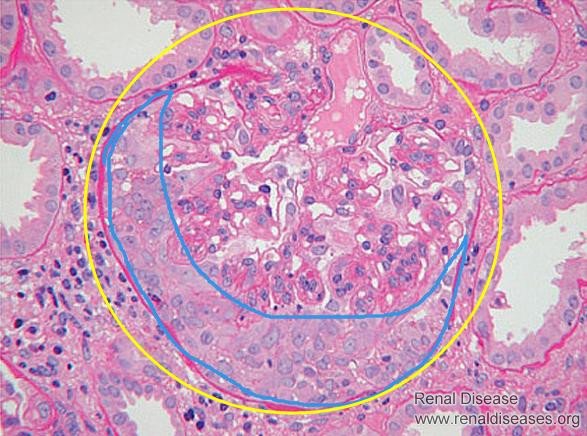Whatsapp: +8615512139310
- Email us:
Today we will talk about crescent nephritis. It is the most dangerous form of kidney disease. In most cases, kidneys can not survive over five years. Once you detect it, please receive treatment as early as possible.

When the glomeruli are removed from the kidney and placed under a microscope (as shown below), you can see the cells in the inner wall of glomerulus (yellow circle) proliferating significantly. Because the proliferated cells deposit into an arc (blue), like a crescent, hence it is named as crescent nephritis.
It is a kind of kidney disease that progresses quickly.
Crescent nephritis has another name: rapidly progressive glomerulonephritis (note: it is not acute nephritis. Acute nephritis is a bacterial infection that can be cured after elimination). But it indeed progresses quickly into uremia within several years. 5-year survival rate of kidney is very low.
There are three types of crescent nephritis:
Type 1 is anti-basal membrane anti-body type. The 5-year survival rate of kidney is 17.6%.
Type 2 is immune complexes type. The 5-year survival rate of kidney is 70.1%.
Type 3 is oligoimmunosedimentary type (without immune complex deposition), and the 5-year survival rate of kidney is 44.3%.
The prognosis of this disease is very dangerous. If not properly treated in time, most patients progress to uremia, and there are few cases of spontaneous remission.
Treatment for crescent nephritis
1. Methylprednisolone pulse therapy, intravenous infusion, applicable to all three types;

2. Immunosuppressive therapy, prednisone + cyclophosphamide;
3. Plasma exchange/double plasma exchange. This is the preferred treatment for type 1 anti-basal ganglia nephropathy, with a plasma exchange every day or the next day until the anti-basal ganglia antibodies are transvaginal. Double plasma exchange is a new technology developed in single membrane plasma exchange, which has more advantages in the security, nutrient loss, plasma usage, etc. Currently it has become an important treatment in clinical multiple disciplines.
Among crescent nephritis, anti-basal ganglia nephropathy is the worst prognosis, and more than 80% of the patients develop into uremia within 5 years. Once oliguria appears and creatinine is more than 600 mol/L, most patients could not recover the kidney, so the treatment could not be delayed.
If you still have any other questions on this glomerulonephritis, please leave a message below or contact online doctor. We are glad to help you.